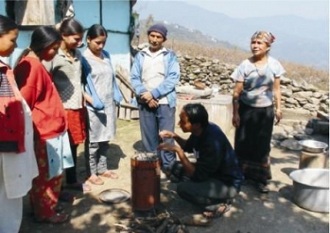Indoor Air. 2011 Oct 10. doi: 10.1111/j.1600-0668.2011.00750.x.
Exposure to indoor air pollutants (polycyclic aromatic hydrocarbons, toluene, benzene) in Mexican indigenous women.
Pruneda-Álvarez LG, Pérez-Vázquez FJ, Salgado-Bustamante M, Martínez-Salinas RI, Pelallo-Martínez NA, Pérez Maldonado IN. Departamento de Toxicología Ambiental, Facultad de Medicina, Universidad Autónoma de San Luis Potosí, San Luis Potosí Facultad de Ciencias Químicas, Universidad Autónoma de San Luis Potosí, San Luis Potosí, México.
Indoor air pollution is considered to be a serious public health issue in Mexico; therefore, more studies regarding this topic are necessary. In this context, we assessed exposure to polycyclic aromatic hydrocarbons (PAHs) and volatile organic compounds in: (i) women who use firewood combustion (indoor) for cooking and heating using traditional open fire; (ii) women who use firewood combustion (outdoor) for cooking and heating using traditional open fire; and (iii) women who use LP gas as the principal energy source.
We studied 96 healthy women in San Luis Potosi, México. Urine samples were collected, and analyses of the following urinary exposure biomarkers were performed by high-performance liquid chromatography: 1-hydroxypyrene (1-OHP), trans, trans-muconic acid, and hippuric acid (HA). The highest levels of 1-OHP, trans, trans-muconic acid, and HA were found in communities where women were exposed to indoor biomass combustion smoke (or products; geometric mean ± s.d., 3.98 ± 5.10 μmol/mol creatinine; 4.81 ± 9.60 μg/l 1-OHP; 0.87 ± 1.78 mg/g creatinine for trans, trans-muconic acid; and 1.14 ± 0.91 g/g creatinine for HA). Our findings indicate higher exposure levels to all urinary exposure biomarkers studied in women who use indoor firewood combustion for cooking and heating (using traditional open fire).
PRACTICAL IMPLICATIONS: High mean levels of 1-hydroxypyrene, t,t-muconic acid, and hippuric acid were found in women who use firewood combustion (indoor) for cooking and heating using traditional open fire and taking into account that millions of women and children in Mexico are living in scenarios similar to those studied in this report, the assessment of health effects in women and children exposed to polycyclic aromatic hydrocarbons and volatile organic compounds is urgently needed. Moreover, it is immediately necessary an intervention program to reduce exposure.



